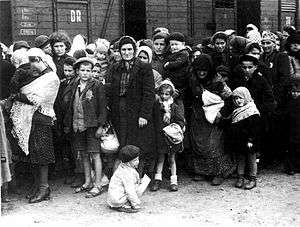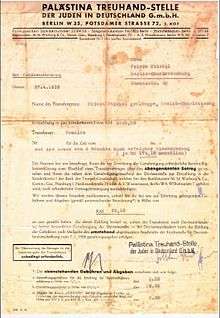Haavara Agreement
| Part of a series on | ||||||||||
| The Holocaust | ||||||||||
|---|---|---|---|---|---|---|---|---|---|---|
 | ||||||||||
|
||||||||||
|
Atrocities |
||||||||||
|
Camps
|
||||||||||
|
Lists Deportations of French Jews
to death camps |
||||||||||
|
Remembrance |
||||||||||
The Haavara Agreement (Hebrew: הסכם העברה Translit.: heskem haavara Translated: "transfer agreement") was an agreement between Nazi Germany and Zionist German Jews signed on 25 August 1933. The agreement was finalized after three months of talks by the Zionist Federation of Germany, the Anglo-Palestine Bank (under the directive of the Jewish Agency) and the economic authorities of Nazi Germany. It was a major factor in making possible the immigration of approximately 60,000 German Jews to Palestine in the years 1933–1939.[1]
The agreement was designed to enable Jews fleeing anti-Semitic persecution under the new Hitler regime to transfer some portion of their assets to their refuge in British Mandatory Palestine. It provided some relief for Jews fleeing by allowing them to recover some of the possessions and assets they were forced to surrender before departing.[2] A portion of those possessions could be re-obtained by transferring them to Palestine as German export goods.[3][4] The agreement was controversial at the time, and was criticised by many Jewish leaders both within the Zionist movement (such as the Revisionist Zionist leader Ze'ev Jabotinsky) and outside it.[4] Rabbi Stephen Wise, president of the American Jewish Congress, said in 1933 'I think I speak the mind of Jews everywhere when I say we hold in abhorrence any Jew, whether in or out of Palestine, who undertakes to make any commercial arrangements with the Nazi government for any reason whatever'.[5] For German Jews, the Agreement offered a way to leave an increasingly hostile environment in Nazi Germany; for the Yishuv, the new Jewish community in Palestine, it offered access to both immigrants and some economic support; and for the Nazis it was seen as a way of breaking the Anti-Nazi boycott of 1933, which had mass support among European Jews and was thought by the German state as a potential threat to a fragile German economy.[4][6]
Background
Although the Nazis won the greatest share of the popular vote in the two Reichstag general elections of 1932, they did not have a majority, so Hitler led a short-lived coalition government formed by the NSDAP and the German National People's Party.[7] Under pressure from politicians, industrialists, and the business community, President Paul von Hindenburg appointed Hitler as Chancellor of Germany on 30 January 1933. This event is known as the Machtergreifung (seizure of power).[8] In the following months, the NSDAP used a process termed Gleichschaltung (co-ordination) to rapidly bring all aspects of life under control of the party.[9] All civilian organisations, including agricultural groups, volunteer organisations, and sports clubs, had their leadership replaced with Nazi sympathisers or party members. By June 1933, virtually the only organisations not in the control of the NSDAP were the army and the churches.[10]
Hanotea company

Hanotea (Hebrew: הנוטע) was a Zionist citrus planting company which served to assist German Jews' emigration to Palestine as part of the Zionist endeavor. In a deal worked out with the German government, Hanotea would receive money from prospective immigrants and use this money to buy German goods. These goods, along with the immigrants, would then be shipped to Palestine. In Palestine, import merchants would then buy the goods from the immigrants, liquidating their investment. This arrangement appeared to be operating successfully, and so paved the way for the later Haavara Agreement. Connected to Hanotea was a Polish Zionist Jew, Sam Cohen. He represented Zionist interests in direct negotiation with the Nazis beginning in March 1933.[11] In May 1933 Hanotea applied for permission to transfer capital from Germany to Palestine.[11]
The Transfer Agreement
| “ | CERTIFICATE The Trust and Transfer Office "Haavara" Ltd. places at the disposal of the Banks in Palestine amounts in Reichmarks which have been put at its disposal by the Jewish immigrants from Germany. The Banks avail themselves of these amounts in Reichmarks in order to make payments on behalf of Palestinian merchants for goods imported by them from Germany. The merchants pay in the value of the goods to the Banks and the "Haavara" Ltd. pays the countervalue to the Jewish immigrants from Germany. To the same extent that local merchants will make use of this arrangement, the import of German goods will serve to withdraw Jewish capital from Germany. |
” |
| — Example of the certificate issued by Haavara to Jews emigrating to Palestine | ||
The Haavara (Transfer) Agreement was agreed to by the German government in 1933, and continued in effect until the German government ceased to support it in 1938. Under the agreement, Jews fleeing persecution in Nazi Germany could use some of their assets to purchase German manufactured goods for export, thus salvaging some part of their personal wealth during emigration. The agreement provided a substantial export market for German factories in British-ruled Palestine. Between November, 1933, and December 31, 1937, 77,800,000 Reichmarks, or $22,500,000, (values in 1938 currency) worth of goods were exported to Jewish businesses in Palestine under the program.[12] By the time the program ended with the start of World War II, the total had risen to 105,000,000 marks (about $35,000,000, 1939 values).[13]
Emigrants with capital of £1,000, (about $5,000 in 1930s currency value) could move to Palestine in spite of severe British restrictions on Jewish immigration under an Immigrant investor program similar to the contemporary EB-5 visa. Under the Transfer Agreement, about 39 percent of an emigrant's funds were given to Jewish communal economic development projects, leaving individuals with about 43% of the value of whatever assets they were able to transfer out of Germany after administrative and shipping costs.[14][15]
The Haavara Agreement was thought among some Nazi circles to be a possible way to rid the country of its supposed "Jewish problem." The head of the Middle Eastern division of the foreign ministry, the anti-Nazi Werner Otto von Hentig, supported the policy of concentrating Jews in Palestine. Hentig believed that if the Jewish population was concentrated in a single foreign entity, then foreign diplomatic policy and containment of the Jews would become easier.[16] Hitler's own support of the Haavara Agreement was unclear and varied throughout the 1930s. Initially, Hitler criticized the agreement, but reversed his opinion and supported it in the period 1937-1939.[17]
After the German invasion of Poland in September 1939, the program was ended.[13]
See also
References
- ↑ http://www.jewishvirtuallibrary.org/jsource/judaica/ejud_0002_0008_0_08075.html
- ↑ Krüger, C. G.. 2009. The English Historical Review 124 (510). Oxford University Press: 1208–10. http://www.jstor.org/stable/40270563.
- ↑ Arab-Israeli Wars: 60 Years of Conflict, Ha Avara, ABC-CLIO, accessed May 7, 2013.
- 1 2 3 Yf’aat Weiss, The Transfer Agreement and the Boycott Movement: A Jewish Dilemma on the Eve of the Holocaust, Yad Vashem Shoah Resource Center, accessed April 28, 2016.
- ↑ Clarence Streit, 'League Aid Asked for German Jews', New York Times (9 September 1933), p.5.
- ↑ Francis R. Nicosia The Third Reich & the Palestine question, pp. 41-49.
- ↑ Evans 2003, pp. 293, 302.
- ↑ Shirer 1960, pp. 183–184.
- ↑ McNab 2009, p. 14.
- ↑ Evans 2005, p. 14.
- 1 2 Francis R. Nicosia: The third Reich & the Palestine question, p. 39 ff.
- ↑ "Haavara Pact Extended for Only 3 Months; Seen Losing Reich's Support". JTA. 8 March 1938. Retrieved 1 May 2016.
- 1 2 "Haavara Winds Up Reich-palestine Transfer Operations; Handled $35,000,000 in 6 Years". JTA. 8 September 1938. Retrieved 1 May 2016.
- ↑ "Reich Migrants to Palestine Get Back 42% of Funds in Cash". JTA. 25 May 1936. Retrieved 2 May 2016.
- ↑ Heritage: Civilization and the Jews (PBS)
- ↑ Francis R. Nicosia The Third Reich & the Palestine question, pp. 132–133.
- ↑ Francis R. Nicosia: The Third Reich & the Palestine question, pp. 140, 142.
Further reading
- Avraham Barkai: German Interests in the Haavara-Transfer Agreement 1933–1939, Yearbook of the Leo Baeck Institute 35; 1990, S. 245–266
- Yehuda Bauer: Jews for sale? Nazi-Jewish Negotiations, 1933-1945, Yale University Press, New Haven, CT, 1996. ISBN 978-0300068528
- Edwin Black: The Transfer Agreement: The Dramatic Story of the Pact Between the Third Reich and Jewish Palestine, Brookline Books, 1999.
- Werner Feilchenfeld, Dolf Michaelis, Ludwig Pinner: Haavara-Transfer nach Palästina und Einwanderung deutscher Juden 1933–1939, Tübingen, 1972
- Tom Segev: The Seventh Million: Israelis and the Holocaust (2000, ISBN 0-8050-6660-8), especially p. 31ff
- David Yisraeli: "The Third Reich and the Transfer Agreement", in: Journal of Contemporary History 6 (1972), S. 129–148
- R. Melka: "Nazi Germany and the Palestine Question", Middle Eastern Studies. Vol. 5 No. 3 (Oct., 1969). pp 221–233.
- Hava Eshkoli-Wagman: "Yishuv Zionism: Its Attitude to Nazism and the Third Reich Reconsidered", Modern Judaism. Vol. 19 No. 1 (Feb., 1999). pp 21–40.
- Klaus Poleken: "The Secret Contacts: Zionism and Nazi Germany 1933–1941". Journal of Palestine Studies. Vol. 5 No. 3/4 (Spring–Summer 1976). pp 54–82.
External links
- Francis R. Nicosia The Third Reich & the Palestine question, Transaction Publishers, 2000.
- "Transfer Agreement" and the Boycott of German Goods